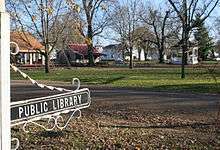Birmingham, Iowa
Birmingham is a city in Van Buren County, Iowa, United States. The population was 448 at the 2010 census.
Birmingham, Iowa | |
|---|---|
| Motto(s): "Gateway to Scenic Van Buren County"[1] | |
 Location of Birmingham, Iowa | |
| Coordinates: 40°52′43″N 91°56′48″W | |
| Country | |
| State | |
| County | Van Buren |
| Area | |
| • Total | 1.06 sq mi (2.74 km2) |
| • Land | 1.06 sq mi (2.73 km2) |
| • Water | 0.00 sq mi (0.01 km2) |
| Elevation | 755 ft (230 m) |
| Population | |
| • Total | 448 |
| • Estimate (2019)[4] | 421 |
| • Density | 398.67/sq mi (153.99/km2) |
| Time zone | UTC-6 (Central (CST)) |
| • Summer (DST) | UTC-5 (CDT) |
| ZIP code | 52535 |
| Area code(s) | 319 |
| FIPS code | 19-06625 |
| GNIS feature ID | 0454645 |
| Website | The Villages of Van Buren, Iowa Website |
Geography
Birmingham is located at 40°52'43" North, 91°56'48" West (40.878626, -91.946610).[7]
According to the United States Census Bureau, the city has a total area of 1.06 square miles (2.75 km2), all land.[8]
Demographics

| Year | Pop. | ±% |
|---|---|---|
| 1850 | 231 | — |
| 1870 | 626 | +171.0% |
| 1880 | 515 | −17.7% |
| 1890 | 545 | +5.8% |
| 1900 | 622 | +14.1% |
| 1910 | 572 | −8.0% |
| 1920 | 539 | −5.8% |
| 1930 | 507 | −5.9% |
| 1940 | 498 | −1.8% |
| 1950 | 643 | +29.1% |
| 1960 | 441 | −31.4% |
| 1970 | 452 | +2.5% |
| 1980 | 410 | −9.3% |
| 1990 | 386 | −5.9% |
| 2000 | 423 | +9.6% |
| 2010 | 448 | +5.9% |
| 2019 | 421 | −6.0% |
| Source:"U.S. Census website". United States Census Bureau. Retrieved 2020-03-29. and Iowa Data Center Source: | ||
2010 census
At the 2010 census there were 448 people, 191 households, and 120 families living in the city. The population density was 422.6 inhabitants per square mile (163.2/km2). There were 213 housing units at an average density of 200.9 per square mile (77.6/km2). The racial makup of the city was 97.8% White, 0.7% African American, 0.2% from other races, and 1.3% from two or more races. Hispanic or Latino of any race were 2.0%.[3]
Of the 191 households 30.9% had children under the age of 18 living with them, 48.2% were married couples living together, 7.9% had a female householder with no husband present, 6.8% had a male householder with no wife present, and 37.2% were non-families. 29.8% of households were one person and 10.5% were one person aged 65 or older. The average household size was 2.35 and the average family size was 2.86.
The median age was 41 years. 23% of residents were under the age of 18; 7% were between the ages of 18 and 24; 24.3% were from 25 to 44; 27.4% were from 45 to 64; and 18.3% were 65 or older. The gender makeup of the city was 51.6% male and 48.4% female.
2000 census
At the 2000 census there were 423 people, 185 households, and 120 families living in the city. The population density was 402.5 people per square mile (155.5/km2). There were 204 housing units at an average density of 194.1 per square mile (75.0/km2). The racial makup of the city was 99.53% White, 0.00% African American, 0.00% Native American, 0.00% Asian, 0.24% Pacific Islander, 0.00% from other races, and 0.24% from two or more races. 0.95%.[10] were Hispanic or Latino of any race.
Of the 185 households 29.2% had children under the age of 18 living with them, 54.6% were married couples living together, 8.1% had a female householder with no husband present, and 35.1% were non-families. 29.7% of households were one person and 17.3% were one person aged 65 or older. The average household size was 2.29 and the average family size was 2.86.
The age distribution was 22.7% under the age of 18, 7.3% from 18 to 24, 29.3% from 25 to 44, 20.3% from 45 to 64, and 20.3% 65 or older. The median age was 40 years. For every 100 females, there were 109.4 males. For every 100 females age 18 and over, there were 103.1 males.
The median household income was $31,406 and the median family income was $40,250. Males had a median income of $27,614 versus $20,536 for females. The per capita income for the city was $15,554. 8.8% of the population and 3.5% of families were below the poverty line. Out of the total population, 10.1% of those under the age of 18 and 11.0% of those 65 and older were living below the poverty line.
Education
The community is served by the Van Buren County Community School District.[11] It was previously in the Van Buren Community School District,[12] until it merged into Van Buren County CSD on July 1, 2019.[13]
Notable people
- Rose Talbot Bullard (1864-1915), doctor and medical professor born in Birmingham[14]
- William S. Ervin, Attorney General of Minnesota[15]
- Clifford R. Hope (1893–1970) congressman representing Kansas 1927-57[16]
References
- "The Villages of Van Buren, Iowa". The Villages of Van Buren, Iowa. Retrieved September 2, 2012.
- "2019 U.S. Gazetteer Files". United States Census Bureau. Retrieved July 17, 2020.
- "U.S. Census website". United States Census Bureau. Retrieved 2012-05-11.
- "Population and Housing Unit Estimates". United States Census Bureau. May 24, 2020. Retrieved May 27, 2020.
- The History of Van Buren County, Iowa: Containing a History of the County, Its Cities, Towns, &c. Western Historical Company. 1878. p. 492.
- "Birmingham, Iowa". City-Data.com. Retrieved September 2, 2012.
- "US Gazetteer files: 2010, 2000, and 1990". United States Census Bureau. 2011-02-12. Retrieved 2011-04-23.
- "US Gazetteer files 2010". United States Census Bureau. Archived from the original on 2012-01-25. Retrieved 2012-05-11.
- "Census of Population and Housing". Census.gov. Retrieved June 4, 2015.
- "U.S. Census website". United States Census Bureau. Retrieved 2008-01-31.
- "Van Buren County" (PDF). Iowa Department of Education. Retrieved 2020-04-05.
- "VAN BUREN." Iowa Department of Education. Retrieved on June 20, 2018.
- "Iowa Educational Directory 2019-2020 School Year" (PDF). Iowa Department of Education. p. 175. Retrieved 2020-04-05. (PDF p. 177/186) - From section "REORGANIZATION & DISSOLUTION ACTIONS SINCE 1965-66"
- Cecilia Rasmussen, "2 Doctors Who Overcame Sexism" Los Angeles Times (February 27, 2000).
- The Legislative Manual of the State of Minnesota. Saint Paul, MN: Minnesota Secretary of State. 1937. p. 482 – via Google Books.
- "HOPE, Clifford Ragsdale". Biographical Directory of the United States Congress. Retrieved 2011-08-03.
External links
| Wikimedia Commons has media related to Birmingham, Iowa. |
- The Villages of Van Buren, Iowa Website Portal style website, Government, Business, Library, Recreation and more
- City-Data Comprehensive statistical data and more about Birmingham